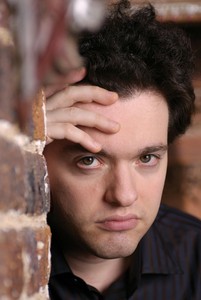
Glenn Gould (Glenn Gould) |
Glenn gould

On the evening of May 7, 1957, very few people gathered for a concert in the Great Hall of the Moscow Conservatory. The name of the performer was not known to any of the Moscow music lovers, and hardly any of those present had high hopes for this evening. But what happened next is sure to be remembered by everyone for a long time.
This is how Professor G. M. Kogan described his impressions: “From the very first bars of the first fugue from Bach’s Art of Fugue, with which the Canadian pianist Glen Gould began his concert, it became clear that we were dealing with an outstanding phenomenon in the field of artistic performance on piano. This impression has not changed, but only strengthened throughout the concert. Glen Gould is still very young (he is twenty-four years old). Despite this, he is already a mature artist and a perfect master with a well-defined, sharply defined personality. This individuality is decisively reflected in everything – both in the repertoire, and in the interpretation, and in the technical methods of playing, and even in the external manner of performance. The basis of Gould’s repertoire is large works by Bach (for example, the Sixth Partita, Goldberg Variations), Beethoven (for example, Sonata, Op. 109, Fourth Concerto), as well as German expressionists of the XNUMXth century (sonatas by Hindemith, Alban Berg). The works of such composers as Chopin, Liszt, Rachmaninoff, not to mention works of a purely virtuoso or salon nature, apparently do not attract the Canadian pianist at all.
- Piano music in the Ozon online store →
The same fusion of classical and expressionist tendencies also characterizes Gould’s interpretation. It is remarkable for the enormous tension of thought and will, amazingly embossed in rhythm, phrasing, dynamic correlations, very expressive in its own way; but this expressiveness, emphatically expressive, is at the same time somehow ascetic. The concentration with which the pianist “disengages” from his surroundings, immerses himself in music, the energy with which he expresses and “imposes” his performing intentions on the audience is amazing. These intentions in some ways, perhaps, are debatable; however, one cannot fail to pay tribute to the performer’s impressive conviction, one cannot help but admire the confidence, clarity, certainty of their embodiment, the precise and impeccable pianistic skill – such an even sound line (especially in piano and pianissimo), such distinct passages, such an openwork, through and through “look through” polyphony. Everything in Gould’s pianism is unique, right down to the techniques. Its extremely low landing is peculiar. His manner of conducting with his free hand during the performance is peculiar… Glen Gould is still at the very beginning of his artistic path. There is no doubt that a bright future awaits him.”
We have cited this short review almost in its entirety, not only because it was the first serious response to the performance of the Canadian pianist, but mainly because the portrait outlined with such insight by the venerable Soviet musician, paradoxically, has retained its authenticity, mainly and later, although time, of course, made some adjustments to it. This, by the way, proves what a mature, well-formed master young Gould appeared before us.
He received his first music lessons in his mother’s hometown of Toronto, from the age of 11 he attended the Royal Conservatory there, where he studied piano in the class of Alberto Guerrero and composition with Leo Smith, and also studied with the best organists in the city. Gould made his debut as a pianist and organist back in 1947, and graduated from the conservatory only in 1952. Nothing foretold a meteoric rise even after he successfully performed in New York, Washington and other US cities in 1955. The main result of these performances was a contract with the record company CBS, which retained its strength for a long time. Soon the first serious record was made – “Goldberg” variations of Bach – which later became very popular (before that, he, however, had already recorded several works by Haydn, Mozart and contemporary authors in Canada). And it was that evening in Moscow that laid the foundation for Gould’s world fame.
Having taken a prominent position in the cohort of leading pianists, Gould led an active concert activity for several years. True, he quickly became famous not only for his artistic achievements, but also for his extravagance of behavior and obstinacy of character. Either he demanded a certain temperature from the concert organizers in the hall, went out on the stage in gloves, then he refused to play until there was a glass of water on the piano, then he started scandalous lawsuits, canceled concerts, then he expressed dissatisfaction with the public, came into conflict with conductors.
The world press went around, in particular, the story of how Gould, while rehearsing the Brahms Concerto in D minor in New York, was so at odds with the conductor L. Bernstein in the interpretation of the work that the performance almost fell apart. In the end, Bernstein addressed the audience before the start of the concert, warning that he could not “take no responsibility for everything that was about to happen”, but he would still conduct, as Gould’s performance was “worth listening to” …
Yes, from the very beginning, Gould occupied a special place among contemporary artists, and he was forgiven a lot precisely for his unusualness, for the uniqueness of his art. He could not be approached by traditional standards, and he himself was aware of this. It is characteristic that, having returned from the USSR, at first he wanted to take part in the Tchaikovsky Competition, but, after thinking, he abandoned this idea; it is unlikely that such original art can fit into the competitive framework. However, not only original, but also one-sided. And the further Gould performed in concert, the clearer became not only his strength, but also his limitations – both repertoire and stylistic. If his interpretation of the music of Bach or contemporary authors – for all its originality – invariably received the highest appreciation, then his “forays” into other musical spheres caused endless disputes, dissatisfaction, and sometimes even doubts about the seriousness of the pianist’s intentions.
No matter how eccentric Glen Gould behaved, nevertheless, his decision to finally leave the concert activity was met like a thunderbolt. Since 1964, Gould did not appear on the concert stage, and in 1967 he made his last public appearance in Chicago. He then publicly stated that he did not intend to perform anymore and wanted to devote himself entirely to recording. It was rumored that the reason, the last straw, was the very unfriendly reception given to him by the Italian public after the performance of Schoenberg’s plays. But the artist himself motivated his decision with theoretical considerations. He declared that in the age of technology, concert life is generally doomed to extinction, that only a gramophone record gives the artist the opportunity to create an ideal performance, and the public the conditions for an ideal perception of music, without interference from neighbors in the concert hall, without accidents. “Concert halls will disappear,” Gould predicted. “Records will replace them.”
Gould’s decision and his motivations caused a strong reaction among specialists and the public. Some sneered, others seriously objected, others – a few – cautiously agreed. However, the fact remains that for about a decade and a half, Glen Gould communicated with the public only in absentia, only with the help of records.
At the beginning of this period, he worked fruitfully and intensively; his name ceased to appear in the heading of the scandalous chronicle, but it still attracted the attention of musicians, critics, and music lovers. New Gould records appeared almost every year, but their total number is small. A significant part of his recordings are works by Bach: six Partitas, concertos in D major, F minor, G minor, “Goldberg” variations and “Well-Tempered Clavier”, two- and three-part inventions, French Suite, Italian Concerto, “The Art of Fugue” … Here Gould again and again acts as a unique musician, like no one else, who hears and recreates the complex polyphonic fabric of Bach’s music with great intensity, expressiveness, and high spirituality. With each of his recordings, he again and again proves the possibility of a modern reading of Bach’s music – without looking back at historical prototypes, without returning to the style and instrumentation of the distant past, that is, he proves the deep vitality and modernity of Bach’s music today.
Another important section of Gould’s repertoire is the work of Beethoven. Even earlier (from 1957 to 1965) he recorded all the concertos, and then added to his list of recordings with many sonatas and three large variation cycles. Here he also attracts with the freshness of his ideas, but not always – with their organicity and persuasiveness; sometimes his interpretations are completely at odds, as noted by the Soviet musicologist and pianist D. Blagoy, “not only with the traditions, but also with the foundations of Beethoven’s thinking.” Involuntarily, sometimes there is a suspicion that deviations from the accepted tempo, rhythmic pattern, dynamic proportions are not caused by a well-thought-out concept, but by the desire to do everything differently from others. “Gould’s latest recordings of Beethoven’s sonatas from opus 31,” wrote one of the foreign critics in the mid-70s, “will hardly satisfy both his admirers and his opponents. Those who love him because he goes to the studio only when he is ready to say something new, not yet said by others, will find that what is missing in these three sonatas is precisely the creative challenge; to others, everything that he does differently from his colleagues will not seem particularly original.
This opinion brings us back to the words of Gould himself, who once defined his goal as follows: “First of all, I strive to avoid the golden mean, immortalized on the record by many excellent pianists. I think it’s very important to highlight those aspects of the recording that illuminate the piece from a completely different perspective. The execution must be as close as possible to the creative act – this is the key, this is the solution to the problem. Sometimes this principle led to outstanding achievements, but in cases where the creative potential of his personality came into conflict with the nature of music, to failure. Record buyers have become accustomed to the fact that each new recording of Gould carried a surprise, made it possible to hear a familiar work in a new light. But, as one of the critics rightly noted, in permanently dumbfounding interpretations, in the eternal striving for originality, the threat of routine also lurks – both the performer and the listener get used to them, and then they become “stamps of originality”.
Gould’s repertoire has always been clearly profiled, but not so narrow. He hardly played Schubert, Chopin, Schumann, Liszt, performed a lot of music of the 3th century – sonatas by Scriabin (No. 7), Prokofiev (No. 7), A. Berg, E. Ksheneck, P. Hindemith, all the works of A. Schoenberg, in which involved the piano; he revived the works of ancient authors – Byrd and Gibbons, surprised fans of piano music with an unexpected appeal to Liszt’s transcription of Beethoven’s Fifth Symphony (recreated the full-blooded sound of the orchestra at the piano) and fragments from Wagner operas; he unexpectedly recorded forgotten examples of romantic music – Grieg’s Sonata (Op. XNUMX), Wiese’s Nocturne and Chromatic Variations, and sometimes even Sibelius sonatas. Gould also composed his own cadenzas for Beethoven’s concertos and performed the piano part in R. Strauss’ monodrama Enoch Arden, and finally, he recorded Bach’s Art of Fugue on the organ and, for the first time sitting at the harpsichord, gave his admirers an excellent interpretation of Handel’s Suite. To all this, Gould actively acted as a publicist, author of television programs, articles and annotations to his own recordings, both written and oral; sometimes his statements also contained attacks that outraged serious musicians, sometimes, on the contrary, deep, albeit paradoxical thoughts. But it also happened that he refuted his literary and polemical statements with his own interpretation.
This versatile and purposeful activity gave reason to hope that the artist had not yet said the last word; that in the future his search will lead to significant artistic results. In some of his recordings, albeit very vaguely, there was still a tendency to move away from the extremes that have characterized him so far. Elements of a new simplicity, rejection of mannerisms and extravagance, a return to the original beauty of the piano sound are most clearly visible in his recordings of several sonatas by Mozart and 10 intermezzos by Brahms; the artist’s performance has by no means lost its inspirational freshness and originality.
It is, of course, difficult to say to what extent this trend would develop. One of the foreign observers, “forecasting” the path of Glenn Gould’s future development, suggested that either he would eventually become a “normal musician”, or he would play in duets with another “troublemaker” – Friedrich Gulda. Neither possibility seemed improbable.
In recent years, Gould – this “musical Fisher”, as journalists called him – remained aloof from artistic life. He settled in Toronto, in a hotel room, where he equipped a small recording studio. From here, his records spread around the world. He himself did not leave his apartment for a long time and only took walks by car at night. Here, in this hotel, an unexpected death overtook the artist. But, of course, Gould’s legacy continues to live on, and his playing strikes today with its originality, dissimilarity with any known examples. Of great interest are his literary works, collected and commented on by T. Page and published in many languages.
Grigoriev L., Platek Ya.





